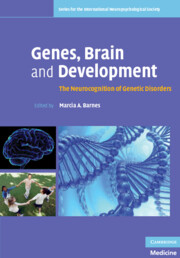Book contents
- Frontmatter
- Contents
- List of Contributors
- Preface
- Acknowledgments
- Section 1 Connecting genes, brain, and behavior in neurodevelopmental disorders
- Section 2 Genetic disorders and models of neurocognitive development
- 4 Language and communication in autism spectrum disorders
- 5 Language development in children with Williams syndrome: New insights from cross-linguistic research
- 6 Language in Down syndrome: A life-span perspective
- 7 Genetic disorders as models of mathematics learning disability: Fragile X and Turner syndromes
- 8 A developmental approach to genetic disorders
- 9 The use of strategies in embedded figures: Tasks by boys with and without organic mild mental retardation: A review and some experimental evidence
- Index
- References
5 - Language development in children with Williams syndrome: New insights from cross-linguistic research
Published online by Cambridge University Press: 04 August 2010
- Frontmatter
- Contents
- List of Contributors
- Preface
- Acknowledgments
- Section 1 Connecting genes, brain, and behavior in neurodevelopmental disorders
- Section 2 Genetic disorders and models of neurocognitive development
- 4 Language and communication in autism spectrum disorders
- 5 Language development in children with Williams syndrome: New insights from cross-linguistic research
- 6 Language in Down syndrome: A life-span perspective
- 7 Genetic disorders as models of mathematics learning disability: Fragile X and Turner syndromes
- 8 A developmental approach to genetic disorders
- 9 The use of strategies in embedded figures: Tasks by boys with and without organic mild mental retardation: A review and some experimental evidence
- Index
- References
Summary
Introduction
Williams syndrome (WS) is a genetically based neurodevelopmental disorder, which is caused by a microdeletion of chromosome 7, more specifically, at the region of chromosome 7q11.23 (Doll & Grzeschik, 2001; Ewart et al., 1993; Korenberg et al., 2000). Due to its uneven cognitive profile, WS has recently been the focus of scientific research in the field of developmental cognitive neuroscience (Clahsen & Almazan, 1998; Clahsen & Temple, 2003; Jordan et al., 2002; Thomas et al., 2001). Impaired visuo-spatial cognition, planning, and problem solving co-occur with relatively spared abilities in the domain of language, social cognition, and face processing (Bellugi et al., 1988; Karmiloff-Smith, 1998; Karmiloff-Smith et al., 1997; Mervis et al., 2000; Tager-Flusberg et al., 2003; Tager-Flusberg & Sullivan, 2000).
There is much controversy surrounding the status and development of the relatively spared cognitive abilities in WS, especially language. More specifically, some researchers argue that language development in WS (and other developmental disorders) reflects the abnormal development of the entire cognitive system (Karmiloff-Smith, 1998; Thomas et al., 2001; Thomas & Karmiloff-Smith, 2002). Consequently, the developmental pattern in WS is expected to be qualitatively different from typical development. If this is the case, then there should not be selective preservation of cognitive abilities in WS while the rest of the system develops abnormally. In other words, there should be no evidence for “residual normality” in WS (Thomas & Karmiloff-Smith, 2002).
- Type
- Chapter
- Information
- Genes, Brain and DevelopmentThe Neurocognition of Genetic Disorders, pp. 105 - 121Publisher: Cambridge University PressPrint publication year: 2010

